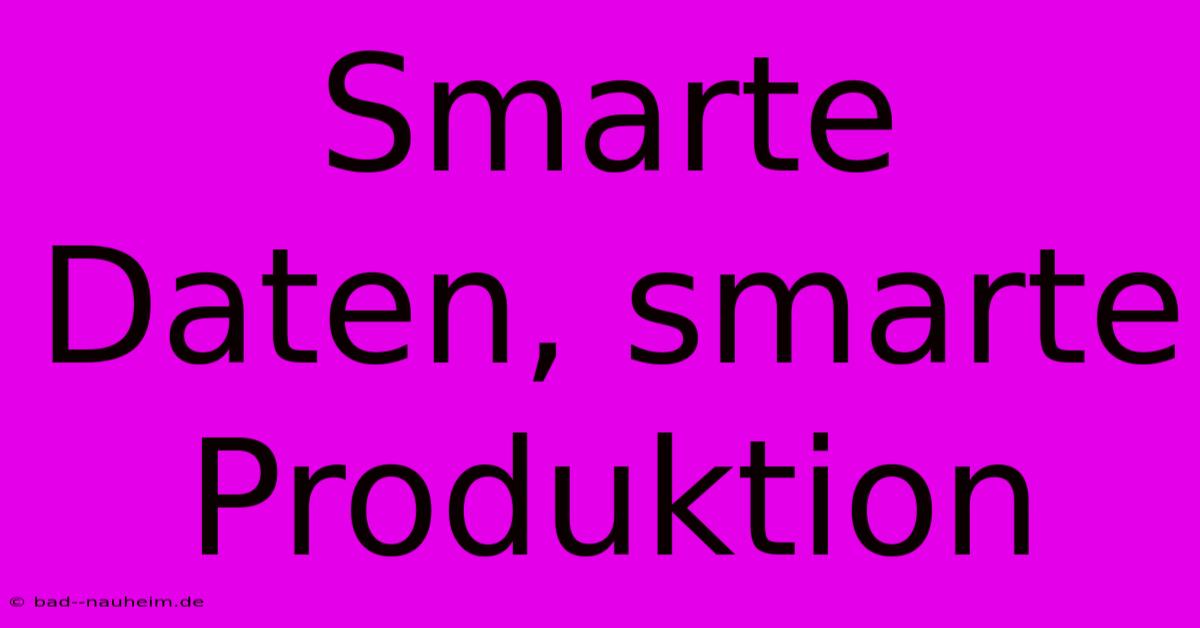Smarte Daten, Smarte Produktion

Discover more detailed and exciting information on our website. Click the link below to start your adventure: Visit Best Website Smarte Daten, Smarte Produktion. Don't miss out!
Table of Contents
Smarte Daten, smarte Produktion: Wie ich gelernt habe, meine Fabrik zu optimieren
Hey Leute! Let's talk about smarte Daten and smarte Produktion. Sounds kinda fancy, right? It was for me, at first. I mean, I’m a factory guy, not a data scientist. But let me tell you, learning to use data to improve my production line was like discovering a whole new world—and it saved my bacon more than once.
Meine Anfangszeit: Chaos und Verwirrung
Back in the day, things were, let’s just say… chaotic. We relied on gut feeling and spreadsheets that looked like they were designed by a caffeinated octopus. We'd constantly miss deadlines, materials were always in short supply, and it felt like we were fighting fires all day. It was stressful AF.
One particularly bad day, we had a major production bottleneck. Turns out, one tiny machine was causing delays the whole time. No one even knew. We were so focused on the bigger picture, we missed the small problems building up. That's when I knew, something had to change. We needed smarte Daten to get a grip on our smarte Produktion.
Der Umstieg auf smarte Datenanalyse
The transition wasn't easy. First, we needed to collect all our data. We started by installing sensors on our machines. These sensors collected data on everything, from machine speed and energy consumption to the number of defective parts. This was a huge undertaking—trust me on this—and there were days I felt like giving up. I wasn't a tech wizard.
Then came the data analysis part. We started using software that visualized our data. It was initially overwhelming, like looking at a Jackson Pollock painting and trying to figure out the meaning. But then we started to see patterns. We realized, for example, that machine downtime was often related to specific shifts or even specific operators. It was pretty eye-opening.
Praktische Tipps für smarte Produktion
Here's what I learned along the way, and how you can use smarte Daten to optimize your smarte Produktion:
- Start small: Don’t try to implement everything at once. Choose one area to focus on, like reducing downtime on a particular machine.
- Identify Key Performance Indicators (KPIs): What metrics really matter to your business? Focus your data collection on those. For me, it was uptime, defect rates, and materials waste.
- Use visualization tools: Spreadsheets are not your friend here. You need software that can show you trends and patterns in your data. This makes it much easier to identify bottlenecks and inefficiencies.
- Embrace predictive maintenance: Using data, you can predict when machines are likely to fail and schedule maintenance accordingly, minimizing downtime. This will really boost your efficiency!
- Involve your team: Get your team involved in the data analysis process. They're the ones on the factory floor, so their insights are invaluable.
Der Erfolg: Mehr Effizienz, weniger Stress
The results were amazing. We reduced downtime by 20%, improved product quality, and increased our overall efficiency. Our team is also happier. Instead of constantly putting out fires, we can now focus on continuous improvement.
Smarte Daten and smarte Produktion aren't magic, they require effort and a willingness to embrace new technologies. But trust me, the benefits are worth it. So, what are you waiting for? Get started with your own data-driven transformation! It’s a game changer!
Zusätzliche Ressourcen (Off-Page SEO)
While I can’t provide specific links here, I recommend researching resources on:
- Industrie 4.0
- Predictive Maintenance Software
- Data Visualization Tools for Manufacturing
- Sensor Technologies in Manufacturing
This should give you a great starting point to begin your own journey into the world of smart data and smart production! Good luck!

Thank you for visiting our website wich cover about Smarte Daten, Smarte Produktion. We hope the information provided has been useful to you. Feel free to contact us if you have any questions or need further assistance. See you next time and dont miss to bookmark.
Featured Posts
-
Film Mittwoch So Packend
Nov 21, 2024
-
Kultstar Zurueck Netflix Stream
Nov 21, 2024
-
Gruenheide Retter Im Dauereinsatz
Nov 21, 2024
-
Neuer Test E Signaturen Fuer Den Rat
Nov 21, 2024
-
Red Bull 42 Black Friday Rabatt
Nov 21, 2024
